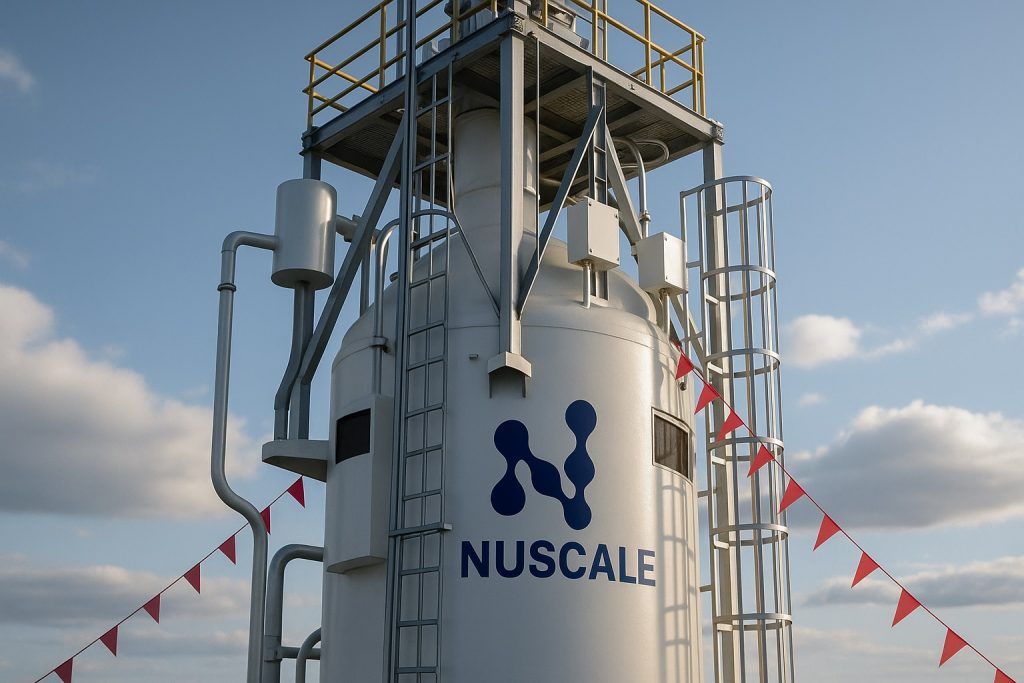- All-Time High: Duke Energy’s stock hit an all-time high of $127.85 per share this week, capping a ~20% year-to-date rally and about 13–17% total return over the past year [1] [2]. The utility giant’s shares are up roughly 62% in five years, outperforming many peer utility stocks [3].
- Safe-Haven Appeal: Investors have poured into Duke and other utilities as a “relatively safe harbor” amid economic uncertainty and shifting interest rate expectations [4]. This defensive demand – coupled with rising energy needs – has fueled Duke’s recent momentum [5]. The stock climbed ~5% in the past month alone and is trading near $128, giving the company a nearly $100 billion market capitalization [6].
- Grid Modernization Push: Duke is investing heavily in modernizing its power grid and expanding capacity. It filed a major Carolinas expansion plan on Oct. 1 to add new gas plants and thousands of megawatts of solar and storage by 2034 while keeping customer bill increases below inflation [7]. In Florida, a $6 billion deal with Brookfield will fund grid upgrades, adding $4 billion to Duke’s capital plan (now $87 billion over 5 years) [8]. One analysis notes these “significant infrastructure and grid modernization investments” are poised to boost efficiency and resilience, driving future growth [9].
- Dividend Strength: The company offers a 3.4% dividend yield and has raised its dividend annually for over 20 consecutive years [10]. It just declared a quarterly payout of $1.065 per share for its 99th straight year of distributions [11]. This steady income stream makes Duke popular among income investors, though its payout ratio is above 100% of earnings, an indicator to watch [12] [13].
- Analyst Outlook: Wall Street is cautiously bullish. About 8 of 18 analysts rate Duke “Buy” (the rest “Hold”, 0 “Sell”) [14]. The median 12-month price target is ~$132, ~4% above current levels [15]. Several analysts recently raised targets into the mid-$130s following strong Q2 earnings and constructive regulation [16] [17]. Evercore ISI, for example, initiated coverage at Outperform with a $143 target, citing Duke’s “efficient capital expenditure recovery mechanisms” [18]. However, one firm (Jefferies) downgraded Duke to Hold, seeing “limited potential for further valuation growth” after the stock’s run-up [19].
Record High on Robust Performance
Duke Energy’s share price has been on a steady upswing, recently reaching a record high of $127.85 [20]. As of October 16, the stock hovers in the upper-$120s after a strong multi-week rally. It closed at $127.02 on Oct. 10 – then its highest level of 2025 [21] – and pushed even higher in the following days. Year-to-date, Duke has returned roughly 15–20% [22] [23], dramatically outperforming the broader utilities sector. Over the past five years, Duke delivered about a 62% total return [24], handily beating many peer utilities and underscoring the company’s steady growth trajectory.
This surge comes even as the overall stock market has experienced volatility. Part of Duke’s strength is due to its profile as a stable, dividend-paying utility – exactly the kind of stock investors favor in uncertain times. “Investors are leaning into reliable utility stocks amid broader economic uncertainty,” observed Simply Wall St analysts, noting that this “has sent fresh capital Duke’s way” and helped lift its price in recent months [25]. With interest rate hikes possibly peaking, income-focused stocks like Duke (which yields ~3.4%) have become more attractive [26]. In effect, Duke has been treated as a safe-haven play, benefiting from a flight to quality and defensive sectors. Consistent earnings and regulated revenue streams add to that appeal, giving investors confidence in Duke’s ability to weather economic ups and downs.
Grid Modernization Driving Growth
A key narrative behind Duke Energy’s bullish case is its aggressive grid modernization and expansion program. The company is in the midst of a massive infrastructure upgrade cycle across its service territories: in August, Duke announced a partnership with Brookfield that injects $6 billion into Duke Energy Florida, funding resilience projects and new capacity [27]. This deal boosted Duke’s planned five-year capital expenditures to $87 billion [28] – one of the largest investment programs in the utility industry. For example, Duke is channeling an incremental $4 billion into the Florida grid to harden systems and support growth [29].
Meanwhile, in the Carolinas (Duke’s home region), demand for electricity is climbing alongside economic and population growth [30]. In response, Duke filed its 2025 Carolinas Resource Plan on October 1, detailing a roadmap to add generation and modernize the grid over the next decade [31]. The plan includes building five new natural gas plants and deploying thousands of megawatts of solar, wind, and battery storage by 2034 [32]. Notably, Duke projects it can meet this rising demand while keeping average annual bill increases around 2.1%, roughly at or below inflation [33]. The strategy is to bolster reliability with new gas and nuclear capacity, integrate more renewables, and upgrade transmission & distribution—all without burdening customers with runaway costs [34] [35].
Analysts say these investments should pay off in improved efficiency and long-term earnings. “Significant infrastructure and grid modernization investment…is positioned to capitalize on growing needs for digitalization and grid resilience,” one analysis noted, adding that such spending enables Duke to “enhance operational efficiency and reliability” and grow its regulated asset base [36]. In other words, today’s big capital projects could translate into higher future profits (as utilities earn returns on capital deployed) and a sturdier grid. Evercore ISI’s analysts highlighted Duke’s “efficient capital expenditure recovery mechanisms” — a nod to regulatory structures that allow Duke to recoup investments and earn a return, which supports the bullish outlook [37]. The favorable regulatory environment, especially in fast-growing states like Florida and North Carolina, has been cited by multiple analysts as a tailwind for Duke [38] [39].
Steady Dividends and Income Appeal
Duke Energy’s shareholder returns aren’t just from price appreciation. The company is a dividend powerhouse, and its 3.4% dividend yield remains a central part of the investment case [40]. Duke has paid a cash dividend for 99 years running and has increased that payout annually for the last 20+ years [41]. Most recently, in August 2025 Duke hiked its quarterly dividend to $1.065 per share (up from $1.045), marking the 21st straight year of raises [42]. This track record places Duke among the elite group of dividend stalwarts (it’s often cited as an S&P Dividend Aristocrat).
Such consistency is a double-edged sword: it attracts income-oriented investors seeking reliable yields, but it also means Duke pays out the bulk of its earnings to shareholders. In fact, Duke’s dividend payout ratio is around 100% of its earnings [43], meaning virtually all profits (and then some) go back to investors as dividends. A payout ratio above 100% isn’t sustainable indefinitely – it implies the company might be funding dividends with debt or asset sales if it persists. Duke’s management has noted that as it invests in growth projects, earnings are expected to rise, which should gradually improve that payout ratio. For now, though, the generous dividend underscores Duke’s commitment to returning cash to investors. It also explains why rising interest rates can pressure the stock: if bond yields become more competitive with a 3–4% dividend yield, some investors might rotate out of utilities. Conversely, the recent stabilization of interest rate expectations has helped keep Duke’s yield attractive relative to safer alternatives [44].
What Do Analysts and Valuations Say?
Most analysts agree that Duke Energy is on solid footing, but there’s debate about how much upside remains after the latest rally. According to data aggregated by Quiver Quant and others, 8 out of 18 analysts covering Duke rate it a “Buy” (or equivalent) and 10 rate it “Hold”, with none advising to sell [45]. The median analyst price target is about $132 per share [46], only a few dollars above the current stock price – suggesting modest upside of roughly 5% in the next year. Some experts see a bit more room: in the past week, firms including BMO Capital, UBS, and Scotia Capital have issued bullish notes, setting price targets in the $135–$137 range [47]. Evercore ISI went even further, initiating coverage with an Outperform rating and a Street-high $143 target [48]. These optimistic calls point to Duke’s strong fundamentals, such as its better-than-expected earnings and constructive regulatory relationships, as reasons the stock can climb higher [49] [50]. Notably, Duke’s Q2 2025 earnings beat forecasts (EPS came in at $1.25 vs. ~$1.18 consensus) [51], which prompted BMO to boost its target and may have contributed to the stock’s recent momentum.
On the other hand, a few analysts urge caution after the stock’s 17% climb over the last year [52]. For instance, Jefferies downgraded Duke from Buy to Hold, stating that after Duke’s successful de-risking (e.g. resolving major uncertainties and shoring up its balance sheet), the valuation now fully reflects those positives [53]. In their view, the stock price already prices in much of Duke’s growth plan, leaving “limited potential for further valuation growth” [54].
Valuation metrics paint a mixed picture. Duke’s forward price-to-earnings (P/E) ratio is around 20–21× based on 2025 earnings estimates [55] [56]. That’s roughly in line with the utility industry average and actually below some large peers – for example, Southern Company trades around 25× and NextEra Energy about 29× earnings [57]. By that comparison, Duke doesn’t look overpriced; its P/E is reasonable for a stable regulated utility with mid-single-digit growth. Similarly, Simply Wall St’s analysis finds Duke’s current P/E very close to its “fair” P/E given the company’s outlook (about 22.1×) [58], suggesting the market has Duke roughly at fair value on an earnings basis.
However, more conservative valuation models indicate the stock might be stretched. A dividend discount model (DDM) – which values a stock by the present value of its future dividends – yields an intrinsic value estimate in the mid-$60s per share for Duke [59]. That is roughly 50% below the recent market price, implying Duke could be overvalued by 90–100% in DDM terms [60]. This stark gap arises because Duke pays out nearly all its earnings as dividends and is not expected to grow those dividends rapidly (the DDM assumed essentially zero dividend growth) [61] [62]. In practice, many analysts discount such a pessimistic valuation, arguing that utilities can sustain high payout ratios and that earnings will indeed grow as Duke’s investments translate to higher revenue. The takeaway is that while Duke isn’t dirt-cheap by fundamental metrics, most observers don’t see it as wildly overvalued either – it’s valued as a solid, steady utility business.
Outlook: Moderate Upside with Modernization Momentum
Looking ahead, Duke Energy’s prospects appear generally positive, though not without challenges. The company is targeting 5–7% annual earnings growth through 2029, driven by its $87 billion capital plan and the accompanying rate base growth [63] [64]. Wall Street consensus expects Duke to earn around $6.32 per share in 2025, up ~7% from 2024, on revenues of about $31.8 billion [65]. If those forecasts pan out, Duke’s ongoing investments in cleaner generation and grid upgrades will be validated by rising profits. Supportive policies – such as federal clean energy incentives and state regulators allowing timely cost recovery – could further bolster Duke’s growth, a point bullish analysts frequently mention [66] [67].
At the same time, there are risks on the horizon. The push toward distributed energy (like rooftop solar and home battery systems) could eventually slow utilities’ growth if customers generate more of their own power [68]. Duke will need to adapt by innovating its business models (for example, offering more grid services or renewable options) to stay ahead of such trends. Additionally, the large capital projects carry execution and regulatory risk: delays or cost overruns on new plants, or unfavorable rulings in rate cases, could dampen the company’s returns. And while interest rates are expected to stabilize, any surprise surge in rates would make Duke’s dividend less attractive and increase its borrowing costs for funding infrastructure.
For now, however, the momentum is on Duke Energy’s side. The combination of record-high stock performance, hefty infrastructure investments, and a reliable dividend stream has put Duke in the spotlight as a top utility pick. “Wall Street bulls look optimistic about Duke”, notes Zacks Investment Research, pointing to generally positive analyst recommendations [69]. The coming months will bring more clarity: Duke’s Q3 2025 earnings report is due on Nov. 7 [70], which will update investors on financial progress and possibly offer new guidance. Any news on grid modernization initiatives or cost trends in that report will be closely watched.
Bottom Line: Duke Energy has ridden a wave of investor enthusiasm to new heights, fueled by its grid modernization push and stable dividends. Most experts believe there is further room for growth – if somewhat limited – given Duke’s solid fundamentals and the supportive outlook for utility spending. As the company powers ahead with upgrading its grid and expanding clean energy capacity, shareholders are poised to benefit from the utility’s next phase of growth, even as prudent observers mind the valuation and industry shifts that lie ahead.
Sources: Duke Energy Company News via Investing.com [71] [72]; Simply Wall St analysis [73] [74]; TechStock² (TS2.tech) commentary [75] [76]; Analyst reports summarized by Yahoo Finance/Zacks [77] [78].
References
1. ph.investing.com, 2. ts2.tech, 3. ts2.tech, 4. simplywall.st, 5. simplywall.st, 6. ph.investing.com, 7. ts2.tech, 8. ts2.tech, 9. simplywall.st, 10. ts2.tech, 11. ts2.tech, 12. simplywall.st, 13. simplywall.st, 14. ts2.tech, 15. ts2.tech, 16. ph.investing.com, 17. ts2.tech, 18. ph.investing.com, 19. ph.investing.com, 20. ph.investing.com, 21. ts2.tech, 22. ph.investing.com, 23. ts2.tech, 24. ts2.tech, 25. simplywall.st, 26. simplywall.st, 27. ts2.tech, 28. ts2.tech, 29. ts2.tech, 30. ts2.tech, 31. ts2.tech, 32. ts2.tech, 33. ts2.tech, 34. ts2.tech, 35. ts2.tech, 36. simplywall.st, 37. ph.investing.com, 38. ph.investing.com, 39. ts2.tech, 40. ph.investing.com, 41. ts2.tech, 42. ts2.tech, 43. simplywall.st, 44. simplywall.st, 45. ts2.tech, 46. ts2.tech, 47. ts2.tech, 48. ts2.tech, 49. ph.investing.com, 50. ph.investing.com, 51. ph.investing.com, 52. simplywall.st, 53. ph.investing.com, 54. ph.investing.com, 55. simplywall.st, 56. simplywall.st, 57. ts2.tech, 58. simplywall.st, 59. simplywall.st, 60. simplywall.st, 61. simplywall.st, 62. simplywall.st, 63. ts2.tech, 64. ts2.tech, 65. ts2.tech, 66. simplywall.st, 67. ph.investing.com, 68. simplywall.st, 69. mlq.ai, 70. ts2.tech, 71. ph.investing.com, 72. ph.investing.com, 73. simplywall.st, 74. simplywall.st, 75. ts2.tech, 76. ts2.tech, 77. ph.investing.com, 78. ph.investing.com







